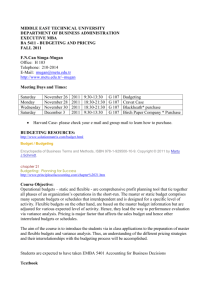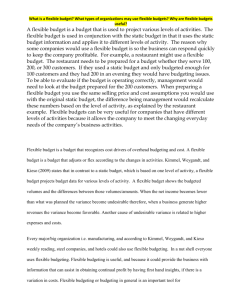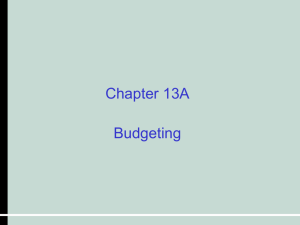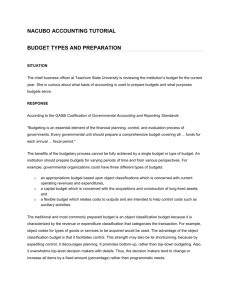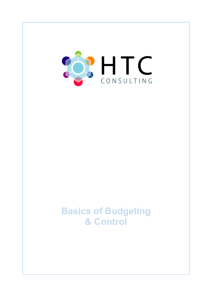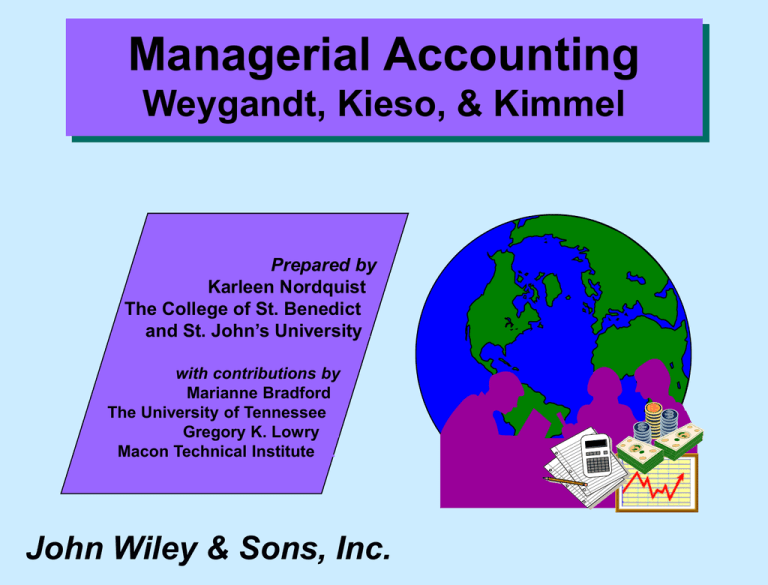
Managerial Accounting
Weygandt, Kieso, & Kimmel
Prepared by
Karleen Nordquist..
The College of St. Benedict...
and St. John’s University...
with contributions by
Marianne Bradford..
The University of Tennessee...
Gregory K. Lowry….
Macon Technical Institute…..
John Wiley & Sons, Inc.
Chapter 6
Budgetary Planning
Chapter 6
Budgetary Planning
After studying this chapter, you should be able to:
1
2
3
4
Indicate the benefits of budgeting.
State the essentials of effective budgeting.
Identify the budgets the comprise the master budget.
Describe the sources for preparing the budgeted
income statement.
5 Explain the principal sections of a cash budget.
6 Indicate the applicability of budgeting in
nonmanufacturing companies.
Preview of Chapter 6
Budgeting Basics
BUDGETARY
PLANNING
• Budgets and Accounting
• Benefits
• Essentials of Effective Budgeting
• Length of Budget Period
• Budgeting Process
• Budgeting and Human Behavior
• Budgeting and Long-Range
Planning
• The Master Budget
Preview of Chapter 6
Preparing the Operating
Budgets
BUDGETARY
PLANNING
• Sales
• Production
• Direct Materials
• Manufacturing Overhead
• Selling and Administrative
Expense
• Budgeted Income Statement
Preview of Chapter 6
Preparing the Financial
Budgets
• Cash
• Budgeted Balance Sheet
BUDGETARY
PLANNING
Budgeting in
Nonmanufacturing
Companies
• Merchandising
• Service
• Non-for-profit
Budgeting Basics
Budgeting is used as a planning tool.
A budget is a formal written summary (or
statement) of management’s plans for a specified
time period, expressed in financial terms.
It normally represents the primary means of
communicating agreed-upon objectives
throughout the business organization.
Accounting information makes major
contributions to the budgeting process.
Study Objective 1
Indicate the benefits of budgeting.
Benefits of Budgeting
The primary benefits of budgeting are as follows:
It requires all levels of management to plan ahead.
It provides definite objectives for evaluating performance.
It creates an early warning system for potential problems.
It facilitates the coordination of activities within the
business.
It results in greater management awareness of the entity’s
overall operations.
It contributes to positive behavior patterns throughout
the organization.
Study Objective 2
State the essentials of effective
budgeting.
Essentials of Effective
Budgeting
Effective budgeting depends on a sound
organizational structure in which authority and
responsibility over all phases of operations are
clearly defined.
Budgets based on research and analysis should
result in realistic goals that will contribute to the
growth and profitability of the company.
The effectiveness of a budget program is directly
related to its acceptance by all levels of
management.
Length of the Budget
Period
The most common budget period is one
year, but a budget may be prepared for any
period of time.
The annual budget is often supplemented by
monthly and quarterly budgets.
A continuous twelve-month budget results
from dropping the month just ended and
adding a future month.
The Budgeting Process
In many companies, the responsibility for
coordinating the preparation of the budget is
assigned to a budget committee.
The budget committee is headed by a budget
director and usually includes the president,
treasurer, chief accountant (controller), and
management personnel from each major area of
the company.
The Budgeting Process
The budget is developed within the framework of a sales
forecast that shows potential sales for the industry and the
company’s expected share of such sales.
Sales forecasting involves consideration of such factors as
– general economic conditions,
– industry trends,
– market research studies,
– anticipated advertising and promotion,
?
– previous market share,
– changes in prices, and
– technological developments.
Budgeting and Human
Behavior
A budget can have a significant effect on human behavior.
A budget may have a strong positive influence on a
manager when:
– Each level of management is invited and encouraged to
participate in developing the budget.
– The budget has the complete support of top management
and it is an important basis for evaluating performance.
– Criticism of a manager’s performance is tempered with
advice and assistance.
– Top management is sensitive to the behavioral
implications of its actions.
Budgeting and Long-Range
Plans
Budgeting and long-range planning are not the same.
The maximum length of a budget is usually a year,
while long-range planning usually encompasses at least
five years.
With budgeting the emphasis is on the achievement of
specific short-term goals. Long-range planning is a
formalized process of selecting strategies to achieve
long-term goals and developing policies and plans to
implement the strategies.
Long-range plans contain considerably less detail than
budgets.
Study Objective 3
Identify the budgets that comprise
the master budget.
The Master Budget
The master budget is a set of
interrelated budgets that constitutes
a plan of action for a specified time
period.
The individual budgets included in
a master budget are shown on the
next slide.
Hayes Company, which sells a
single product, Kitchen-mate, will
be used as an example.
Components of the Master
Budget
Illustration 6-2
Sales Budget
Production
Budget
Direct Labor
Budget
Direct Labor
Budget
Direct Labor
Budget
Operating
Budgets
Budgeted
Balance Sheet
Financial
Budgets
Selling &
Administrative
Expense Budget
Budget Income
Statement
Capital
Expenditure
Budget
Cash Budget
Two Classes of Budgets in
the Master Budget
Operating budgets include the
individual budgets that culminate
in the preparation of the
budgeted income statement.
Financial budgets include the
cash budget and the budgeted
balance sheet. These budgets
focus primarily on the cash
resources needed to fund
expected operations and planned
capital expenditures.
Preparing the Operating Budgets:
Sales Budget
The sales budget is the first budget prepared.
Each of the other budgets depends on the sales
budget.
It is derived from the sales forecast, and it
represents management’s best estimate of
sales revenue for the budget period.
?
Preparing the Operating Budgets:
Sales Budget
The sales budget is prepared by multiplying the expected unit
sales volume for each product by its anticipated unit selling price.
For Hayes Company, sales volume is expected to be 3,000 units in
the first quarter with 500-unit increments in each succeeding year.
Based on a sales price of $60 per unit, the sales budget for the year
by quarters is shown below:
Hayes Company
Sales Budget
For the Year Ending December 31, 1999
Quarter
Expected unit sales
Unit selling price
Total sales
1
3,000
x $60
2
3,500
x $60
3
4,000
x $60
4
4,500
x $60
Year
15,000
x $60
$180,000
$210,000
$240,000
$270,000
$900,000
Illustration 6-3
Preparing the Operating Budgets:
Production Budget
The production budget shows the units that
must be produced to meet anticipated sales.
A realistic estimate of ending inventory is
essential in scheduling production requirements.
The production requirements formula is:
Budgeted
Sales Units
Desired
Ending
Finished
Goods Units
Beginning
Finished
Goods
Units
Required
Production
Units
Illustration 6-4
Preparing the Operating Budgets:
Production Budget
Hayes believes it can meet future sales
requirements by maintaining an ending
inventory equal to 20% of the next quarter’s
budgeted sales volume.
For example, the ending finished goods
inventory for the first quarter is 700 units
(20% x anticipated second-quarter sales of
3,500 units).
The production budget is shown on the next
slide.
Preparing the Operating Budgets:
Production Budget
Hayes Company
Production Budget
For the Year Ending December 31, 1999
Quarter
2
3,500
800
4,300
700
3
4,000
900
4,900
800
4
4,500
1,000b
5,500
900
Year
Expected unit sales (sales budget)
Add: Desired ending FG unitsa
Total required units
Less: Beginning FG units
1
3,000
700
3,700
600c
Required production units
3,100
3,600
4,100
4,600
15,400
a20%
of next quarter’s sales
2000 first-quarter sales, 5000 units x 20%
c20% of estimated first-quarter 1999 sales units
bExpected
Illustration 6-5
Preparing the Operating Budgets:
Direct Materials Budget
The direct materials budget contains both the
quantity and cost of direct materials to be
purchased.
It is derived from the direct materials units
required for production (per production budget)
plus the desired ending direct materials units less
the beginning direct materials units.
Direct
Materials
Units
Required for
Production
Desired
Ending Direct
Materials
Units
Beginning
Direct
Materials
Units
Required
Direct
Materials
Purchases
Units
Illustration 6-6
Preparing the Operating Budgets:
Direct Materials Budget
Because of its close proximity to its suppliers,
Hayes Company has found that an ending
inventory of raw materials equal to 10% of the
next quarter’s production is sufficient.
The manufacture of each Kitchen-mate
requires 2 pounds of raw materials and the
expected cost per pound is $4.
The direct materials budget is shown on the
next slide.
Preparing the Operating Budgets:
Direct Materials Budget
Hayes Company
Direct Materials Budget
For the Year Ending December 31, 1999
Quarter
1
2
3
4
3,100
Units to be produced (from
x
2
production budget)
6,200
Direct materials per unit
720
Total pounds needed for production
6,920
Add: Desired ending DM
620c
Total materials required
6,300
Direct materials purchases
x
$4
Cost per pound
3,600
x
2
7,200
820
8,020
720
7,300
x
$4
4,100
x
2
8,200
920
9,120
820
8,300
x
$4
4,600
x
2
9,200
1,020b
10,220
920
9,300
x
$4
$25,200
$29,200
$33,200
$37,200
Total cost of DM purchases
Year
$124,800
a10%
of next quarter’s production
bEstimated 2000 first-quarter pounds needed for production, 10,200 x 10%
c10% of estimated first-quarter 1999 pounds needed for production
Illustration 6-7
Preparing the Operating Budgets:
Direct Labor Budget
The direct labor budget contains the quantities (hours) and cost
of direct labor necessary to meet production requirements.
At Hayes Company, two hours of direct labor are required to
produce each unit of finished goods, and the anticipated hourly
wage rate is $10. The direct labor budget is shown below:
Hayes Company
Direct Labor Budget
For the Year Ending December 31, 1999
Quarter
1
2
3
4
Units to be produced (from
production budget)
Direct labor time per unit
Total required direct labor hours
Direct labor cost per hour
3,100
x
2
6,200
x $10
3,600
x
2
7,200
x $10
4,100
x
2
8,200
x $10
4,600
x
2
9,200
x $10
Total direct labor cost
$62,000
$72,000
$82,000
$92,000
Year
$308,000
Illustration 6-8
Preparing the Operating Budgets:
Manufacturing Overhead Budget
The manufacturing overhead budget on the next slide
shows the expected manufacturing overhead costs for
the budget period.
This budget distinguishes between fixed and variable
overhead costs.
The fixed cost amounts are assumed, and Hayes expects
the following variable costs per direct labor hour:
– indirect materials: $1.00
– indirect labor: $1.40
– utilities: $0.40
– maintenance: $0.20
Preparing the Operating Budgets:
Manufacturing Overhead Budget
Hayes Company
Manufacturing Budget
For the Year Ending December 31, 1999
Variable Costs
Indirect materials
Indirect labor
Utilities
Maintenance
Total variable
Fixed costs
Supervisory salaries
Depreciation
Property tax and insurance
Maintenance
Total manufacturing overhead
Direct Labor hours
1
$ 6,200
8,680
2,480
1,240
18,600
Quarter
2
3
$ 7,200
$ 8,200
10,080
11,480
2,880
3,280
1,440
1,640
21,600
24,600
4
$ 9,200
12,880
3,680
1,840
27,600
20,000
3,800
9,000
5,700
38,500
20,000
3,800
9,000
5,700
38,500
20,000
3,800
9,000
5,700
38,500
20,000
3,800
9,000
5,700
38,500
$57,100
6,200
$60,100
7,200
$63,100
8,200
$66,100
9,200
Manufacturing overhead rate per direct labor hour ($246,400
30,000)
Year
$246,400
30,800
$ 8.00
Illustration 6-9
Preparing the Operating Budgets:
Selling & Administrative Budget
The selling and administrative expense budget
on the next slide is a projection of anticipated
operating expenses.
This budget also distinguishes between fixed and
variable costs.
Once again, the fixed cost amounts are assumed, and
Hayes expects the following variable costs per unit
sold (from sales budget):
– sales commissions: $3.00
– freight-out: $1.00
Preparing the Operating Budgets:
Selling & Administrative Budget
Hayes Company
Selling & Administrative Budget
For the Year Ending December 31, 1999
Quarter
Variable Costs
Sales commissions
Freight-out
Total variable
Fixed costs
Advertising
Sales salaries
Depreciation
Property taxes and insurance
Total fixed
Total selling and administrative
expenses
1
$ 9,000
3,000
12,000
2
$ 10,500
3,500
14,000
3
$ 12,000
4,000
16,000
4
$ 13,500
4,500
18,000
5,000
15,000
7,500
1,000
1,500
30,000
5,000
15,000
7,500
1,000
1,500
30,000
5,000
15,000
7,500
1,000
1,500
30,000
5,000
15,000
7,500
1,000
1,500
30,000
$42,000
$44,000
$46,000
$48,000
Year
$180,000
Illustration 6-10
Study Objective 4
Describe the sources for preparing
the budgeted income statement.
Budgeted Income Statement
The budgeted income statement is the important endproduct in preparing operating budgets.
This budget indicates the expected profitability of
operations and it provides a basis for evaluating
company performance.
Hayes’ budgeted income statement is prepared with
data from all of the detailed operating budgets and the
following additional information:
– Interest expense is expected to be $100.
– Income tax expense is expected to be $12,000.
Budgeted Income Statement
Hayes Company
Budgeted Income Statement
For the Year Ending December 31, 1999
Sales
Cost of goods sold (15,000 x $44)
Gross profit
Selling & administrative expenses
Income from operations
Interest expense
Income before income taxes
Income tax expense
$900,000
660,000
240,000
180,000
60,000
100
59,900
12,000
Net income
$ 47,900
Illustration 6-12
Study Objective 5
Explain the principal sections of a
cash budget.
Preparing the Financial Budgets:
Cash Budget
The cash budget shows anticipated cash flows.
Because cash is so vital in a company, this budget is
often considered to be the most important output in
preparing financial budgets.
A cash budget contributes to more effective cash
management.
The cash budget contains three sections:
– cash receipts.
– cash disbursements.
– financing.
Preparing the Financial Budgets:
Basic Form of Cash Budget
The cash receipts section includes expected receipts from cash sales,collections
from customers, interest and dividends, and proceeds from sales of assets and
stock.
Illustration 6-13
The cash disbursements
section shows expected
payments for direct materials,
direct labor, manufacturing
overhead, selling &
administrative expenses,
income taxes, dividends, and
assets.
Any Company
Cash Budget
Beginning cash balance
$x,xxx
Add: Cash receipts (itemized)
x,xxx
Total cash available
x,xxx
Less: Cash disbursements (itemized) x,xxx
Excess (deficiency) of available cash
x,xxx
over cash disbursements
Financing
x,xxx
Ending cash balance
$x,xxx
The financing section shows expected borrowings and the repayment of
borrowed funds plus interest. This section is needed when there is a cash
deficiency or when the cash balance is below management’s minimum required
balance.
Collections from
Customers
Preparing a schedule of cash collections from customers is useful
in preparing a cash budget. Assume that Hayes’ credit sales per the
Sales Budget (amounts shown in parentheses below) are collected
60% in the quarter sold and 40% in the following quarter.
Accounts Receivable of $60,000 at December 31, 1998 are
expected to be collected in full the first quarter of 1999.
Schedule of Expected Collections from Customers
Quarter
Accounts receivable, 12/31/98
First quarter ($180,000)
Second quarter ($240,000)
Third quarter ($240,000)
Fourth quarter ($270,000)
Total collections
1
$ 60,000
108,000
$168,000
2
$ 72,000
126,000
3
$ 84,000
144,000
$198,000 $228,000
4
$ 96,000
162,000
$258,000
Illustration 6-14
Payments for Direct
Materials
Preparing a schedule of payments for direct materials is also
useful in preparing a cash budget. Assume that Hayes’ purchases of
direct materials per the Direct Materials Budget (amounts shown in
parentheses below) are paid 50% in the quarter purchased and 50%
in the following quarter. Accounts Payable of $10,600 at
December 31, 1998 are expected to be paid in full the first quarter
of 1999.
Schedule of Expected Payments for Direct Materials
Quarter
Accounts payable, 12/31/98
First quarter ($180,000)
Second quarter ($240,000)
Third quarter ($240,000)
Fourth quarter ($270,000)
Total collections
Illustration 6-14
1
$ 10,600
12,600
$23,200
2
$ 12,600
14,600
$27,200
3
$ 14,600
16,600
$31,200
4
$ 16,600
18,600
$35,200
Other Assumptions for Hayes
Company Cash Budget
The January 1, 1999, cash balance is expected to be $38,000.
Management wishes to maintain a $15,000 minimum cash balance.
Marketable securities are expected to be sold for $2,000 cash in the
first quarter.
All direct labor is paid in the quarter incurred.
All manufacturing overhead and selling & administrative expenses
except depreciation are paid in the quarter incurred.
Management plans to purchase a new truck in the second quarter for
$10,000 cash.
The company makes equal quarterly payments of its estimated annual
income taxes.
Loans are repaid in the first subsequent quarter in which there is
sufficient cash.
Hayes Company
Cash Budget
For the Year Ending December 31, 1999
Illustration 6-16
Beginning cash balance
Add: Receipts
Collections from customers
Sale of securities
Total receipts
Total available cash
Less: Disbursements
Direct materials
Direct labor
Manufacturing overhead
Selling & administrative expenses
Purchase of truck
Income tax expense
Total disbursements
Excess (deficiency) of available cash
over disbursements
Financing
Borrowings
Repayments (plus $100 interest)
Ending cash balance
1
$ 38,000
Quarter
2
3
$ 25,500 $ 15,000
4
$ 19,400
168,000
2,000
170,000
208,000
198,000
0
198,000
223,500
228,000
0
228,000
243,000
258,000
0
258,000
277,400
23,200
62,000
53,300
41,000
0
3,000
182,500
27,200
72,000
56,300
43,000
10,000
3,000
211,500
31,200
82,000
59,300
45,000
0
3,000
220,500
35,200
92,000
62,300
47,000
0
3,000
239,500
25,500
12,000
22,500
37,900
0
0
3,000
0
0
3,100
0
0
$ 25,500
$ 15,000
$ 19,400
$ 37,900
Budgeted Balance Sheet
The budgeted balance sheet is a projection of financial
position at the end of the budget period.
It is developed from the budgeted balance sheet for the
preceding year and the budgets for the current year.
Pertinent data for Haye’s balance sheet which follows are:
Building and equipment
Accumulated depreciation
Common stock
Retained earnings
$182,000
28,000
225,000
46,480
Hayes Company
Budgeted Balance Sheet
December 31, 1999
Illustration 6-17
ASSETS
Cash (Cash budget)
$ 37,900
Accounts receivable (Schedule of collections
108,000
from customers)
Finished goods inventory (Production budget x $44)
44,000
Raw materials inventory (DM budget x $4)
5,080
Buildings & Equipment (Beg balance on previous slide
$ 192,000
plus new truck on Cash budget))
Less: Accumulated Depreciation (Beg balance on previous
48,000 144,000
slide plus depr exp from MO and S&A exp budgets)
Total assets
$337,980
LIABILITIES AND STOCKHOLDERS’ EQUITY
Accounts payable (Schedule of payments)
Common stock (previous slide)
Retained earnings (Beginning balance on previous slide
plus NI from Budgeted income statement)
$ 18,600
225,000
94,380
Total liabilities and stockholders’ equity
$337,980
Study Objective 6
Indicate the applicability of
budgeting in nonmanufacturing
companies
Budgeting in Nonmanufacturing
Companies
Budgeting is not limited to manufacturing
companies.
Budgets may also be used in profit planning
by:
– merchandising companies.
– service enterprises.
– not-for-profit organizations.
Budgeting in
Merchandising Companies
The major differences between the budgets of a
merchandising company and a manufacturing company are
that a merchandiser:
uses a merchandise purchases budget instead of a
production budget, and
does not use the manufacturing budgets (direct materials,
direct labor, and manufacturing overhead).
The formula for determining budgeted merchandise purchases is:
Budgeted
Cost of
Goods Sold
Desired
Ending
Merchandise
Inventory
Beginning
Merchandise
Inventory
Required
Merchandise
Purchases
Illustration 6-18
Budgeting in Service
Enterprises
In service enterprises, such as a public
accounting firm, a law office, or a medical
practice, the critical factor in budgeting is
coordinating professional staff needs with
anticipated services.
Service Enterprises
If a firm is overstaffed:
Labor costs will be
disproportionately
high.
Profits will be lower
because of the
additional salaries.
Staff turnover will
increase because of
lack of challenging
work.
If an enterprise is understaffed:
Revenue may be lost because
existing and prospective
client needs for service cannot
be met, and
Professional staff may seek
other positions because of
excessive work loads.
Budgeting in Not-for-Profit
Organizations
Budgeting is just as important for not-forprofit organizations as for profit-oriented
enterprises.
In most cases, not-for-profit entities
budget on the basis of cash flows
(expenditures and receipts), rather than on
a revenue and expense basis.
The starting point in the budgeting
process is usually expenditures, not
receipts.
Copyright
Copyright © 1999 John Wiley & Sons, Inc. All rights reserved.
Reproduction or translation of this work beyond that named in
Section 117 of the 1976 United States Copyright Act without the
express written permission of the copyright owner is unlawful.
Request for further information should be addressed to the
Permissions Department, John Wiley & Sons, Inc. The purchaser
may make back-up copies for his/her own use only and not for
distribution or resale. The Publisher assumes no responsibility for
errors, omissions, or damages, caused by the use of these programs
or from the use of the information contained herein.
Chapter 6
Budgetary Planning


